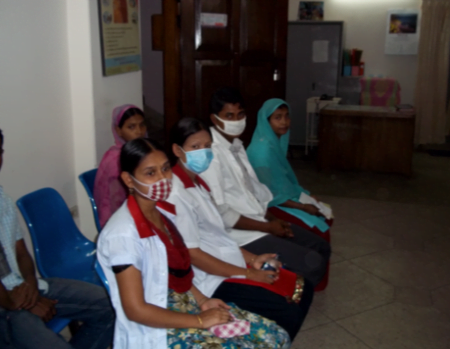Dhaka, Bangladesh – The challenge of fighting TB is greatest in the vast growing urban centers of Bangladesh. The National TB Control Program is actually far more effective in rural villages than in big cities like Dhaka. Everyday, millions of people who live in tightly cramped quarters pack into overloaded buses to work in a garment factories. This makes for a perfect breeding ground for TB.
On top of this, the population here is very mobile. Millions of people come and go, working for short stints in the city before returning to their villages. This makes treatment exceedingly difficult.
Since 2004, the Global Fund to Fight AIDS TB and Malaria provided several grants to help diagnose and treat TB in urban centers. I visited two of these TB treatment centers today, World TB day 2011.
The important thing to know about TB treatment is that you cannot simply give the patients the drugs to take on their own. If left to their own devices, patients often take just enough of the drug to cure the symptoms, but not enough to rid of the disease. This potentially causes deadly, drug-resistant strains of the virus to emerge. So, WHO guidelines stipulate that patients must be observed taking their drugs. This is called the Directly Observed Treatment Short-Course, DOTS.
The thing is, it can be cumbersome — if not impossible — to visit to a hospital everyday to receive a dose. The aim of a TB intervention program is to make it as easy as possible for people to receive a diagnosis and then adhere to a treatment regimen, which includes taking a pill a day every day for several months.
Through one Global Fund grant the government set up 137 Urban Primary Care Centers where TB can be diagnosed and DOTS program implemented. Through a second grant from the Global Fund the association of of garment manufacturers added TB intervention services to 10 medical centers they already operated.
The garment industry is by far the single biggest private sector employer in Bangladesh. Some three million Bangladeshi’s are garment workers. Brands like Speedo, Polo, Timberland and Izod are manufactured in factories here. Minimum wage is $55 a month.
A clinic like this one cares for just a fraction of those workers, but those numbers are increasing. These medical centers can make a TB diagnosis and they administer the DOTs program directly at the factories.
On the public sector side, there are 137 public treatment centers in the six major cities in Bangladesh. 63 of these are in Dhakha, a city with a population of about 13 million.
Below, a patient receives her TB medicine from a government-run health care facility in Dhaka.


DOTS in action.
These treatment centers are a start, but considering the prevalence of TB in Bangladesh more intervention is needed. One particular concern which the director of one the Urban Primary Care Center shared was what he called Dhaka’s “floating” population. These are people who come to the city from the villages for temporary employment and have no fixed address. He estimates about 1 million people fit this description.
Last year, his team conducted a survey of people sleeping in the railway station who were symptomatic for TB. Of the 678 people they tested, 81 were positive. That is a prevalence rate that is much, much higher than the 426/100,000 national average. Reaching this population is key to controlling TB in Bangladesh.
So, the bottom line take-away is that progress on urban TB has been very significant since these programs were implemented, but compared to the overall needs of the population, there is still a long way to go to reach the goal of universal coverage for TB diagnosis and treatment.



